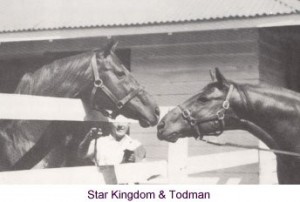The Dark Jewel Legacy
By Harley Walden
When the wonderful broodmare Dark Jewel passed in 1971 she left an enormous legacy to the Australian racing industry.
Dark Jewell was from the second crop of the great Star Kingdom and was purchased on behalf of the Tait family by Randwick trainer Fil Allotta at the 1955 Yearling Sales.
Allotta went to $2,310 to secure the filly, but considered the money well spent. In years to come Allotta’s judgment proved spot on.
Dark Jewell was foaled in 1953, and was the result of a mating between Star Kingdom and the Excitement mare Red Lace.
 Red Lace’s dam, Red Clover, was by Iliad, a son of Swynford from Red Shank, by Thrice from Red Streak, by Wallace a son of Carbine.
Red Lace’s dam, Red Clover, was by Iliad, a son of Swynford from Red Shank, by Thrice from Red Streak, by Wallace a son of Carbine.
Wallace sired the winners of 949 races. Between them progeny of the stallion won $492,290 in prizemoney.
Dark Jewell could hardly be described as a top racehorse, she was successful in three events. She won twice at Canterbury and once at Warwick Farm and accumulated very little in prizemoney.
Red Lace, the dam of Dark Jewell, was a very fine broodmare and produced eleven foals at stud. Of these six raced and three were winners.
The odds of Dark Jewell being a successful matron were good. She was lightly raced and very well bred.
It was in the capacity of a matron Dark Jewell found her true destiny. The mention of her name is enough to grab even the most casual listener’s attention. From 1958 until her death Dark Jewel produced ten foals. Of these nine reached the racecourse. Without exception they won races. The only foal not to race was destroyed at an early age after breaking a leg. That was a filly by Persian Book, foaled in 1961.
In her first season at stud Dark Jewel was mated with the beautifully bred French stallion, Wilkes (Fr). The result of the union was a colt, Gingerbread. Gingerbread was only ordinary, as was Powella, his half-brother by Rawson, produced in the following season. Powella won only one race, a Novice at Warwick Farm. These two were produced in 1958 and 1959.
In 1960, the mare had a much better result when mated with the Nasrullah stallion, Rego. When covered by Rego, Dark Jewel threw the classy filly Heirloom.
Heirloom was the top filly in her two-year season winning the Maribyrnong Plate, 5furlongs, and other races. At three years she was successful in the 1,000 Guineas.
Heirloom won nine races and was placed in such prestigious events as the Stradbroke Handicap, Healy Stakes, Epsom Handicap, Craven “A” and others.
Heirloom, unfortunately, is now dead, but other fillies continued to produce stock. Included among these was Snuff Box, dam of Snuff. Also left to carry on were Memories and the brilliant Blue Mountain.
The 1961 saw the Persian Book filly destroyed.
Dark Jewel’s next racing representative was Betelgeuse who was foaled in 1962. Betelgeuse was by Wilkes, who seized the opp0rtunity to improve on Gingerbread. This he did. Betelgeuse was an infinitely better racehorse than his brother and won thirteen races and $36,845 in stakes. Gingerbread had won three races and $4,270.
Betelgeuse was a handy horse and was successful in such races as the Lightning Handicap, City Tatts Club Stakes 5f, and the Shorts 6f. The flashy Wilkes Fr horse retired to stud but did not do as well as was expected.
Dark Jewel produced the first of her champions in 1963. He too was a chestnut and was sired by the imported stallion Edmundo. Edmundo enjoyed great success in this country and was eventually exported to America, but, in company with Dark Jewel, gave us the class performer Cabochon.
Cabochon was gelded at an early age and subsequently developed into one of the most genuine performers ever. A good-looking chestnut, Cabochon was easily distinguished by his pale-blue blinker hood allied with the familiar Tait colours, made Cabochon easy to see, even in the largest field.
Cabochon first came to prominence in in the autumn of 1967. Only a three-year-old, Cabochon was caught in the last few strides of the AJC Doncaster 8f., by the great Tobin Bronze.
Tobin Bronze humped 9st 5lb compared to Cabochon’s 7.5.
Nevertheless, it was a very good effort from a horse still eligible for restricted class races.
Connections, realizing they had a good one, put Cabochon away with the AJC Epsom in mind. He returned to racing a much stronger horse. He duly won the Epsom, easily defeating Royal Rene and Auto Filou. The time was a very fast 1.34.4. This was only .02 outside the course record set by Fine and Dandy in the 1961 Doncaster Handicap.
The long striding son of Dark Jewel became somewhat of a traveller after that, and won or was placed in some of the major Eastern state handicaps. During his career Cabochon won an Epsom Handicap, Stradbroke Handicap, Boroolong Handicap and the Windsor Flying Handicap. He was placed in two Doncasters; to Tobin Bronze and Unpainted; the Craven A Stakes to Ija Ninja and second to Black Onyx in the Doomben 10,000.
At his career’s end, Cabochon boasted fifteen wins, sixteen seconds, seven seconds and seven fourths and $106,190 prizemoney.
Cabochon raced into his seventh year, his career took in sixty eight starts. The champion almost always gave of his best in races and brought glory on his dam.
Dark Jewel’s 1964 foal was a beautiful bay filly by Rego. Birthright she was called, never reached the heights attained by her sister, Heirloom or her half-brothers, Cabochon and Betelgeuse. However she was a competent racehorse and was successful eight times, from 5 furlongs to 7 furlongs and won $27,310. Birthright’s best win was in the Maribynong Plate, a race also won by Heirloom.
Dark Jewel again missed in 1968, this time to Sostenuto, however she returned a positive test to that stallion the following season. The resultant foal Star Facet lived up to the family tradition in as she did win. She was only kept in training a short time before being retired to stud.
King of Babylon* was the sire of Dark Jewel’s last foal, which raced as Briolette. This filly also won and so gave Dark Jewel the perfect record. The mare produced nine foals which made it to the track, and each, as stated earlier, managed to win.
One wonders why so much emphasis is placed on stallions by breeders and public alike.
Dark Jewel was mated with various stallions over a long period of time, and apart from the occasional lapse, her foals were consistently high quality. Heirloom, Cabochon and Baguette were exceptionally good, judged not by money won, but the class of event they managed to capture. Between them the trio annexed 2 Maribyernong Plates, Silver Slipper, Golden Slipper, AJC Sires Produce and Champagne Stakes. They also got away with 2 Booroolong Handicaps an Epsom, Ten Thousand and a Stradbroke Handicap, as well as a dead-heat for first in the One Thousand Guineas.
They are only a few of the races won by Dark Jewel’s progeny. Add to these the non-feature events and the total races won are over the half century mark.
Cabochon and Baguette, just two of the family, eclipsed $302,190, which is truly staggering. It is hoped that the dynasty established by the great mare can continue. Heirloom following in her dam’s footsteps, has thrown winners, and they in turn have done the same. Betelgeuse, Star Facet and company have been represented on the racetrack. Hopefully for Australian breeding the blood of one of our great broodmares will continue to flow many of our future champions.
 scone.com.au
scone.com.au